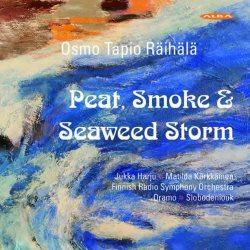| 
|
Osmo Tapio RÄIHÄLÄ (b. 1964)
Peat, Smoke and Seaweed Storm
Barlinnie Nine (1999) [11:33]
Soliloque 2: La tornade (2012) [7:37]
Rautasade Iron Rain (2008) [15:32]
Aflao Highway (2011) [12:52]
Ardbeg (The Ultimate Piece for Orchestra) (2003) [17:04]
Jukka Harhu (french horn) (Soliloque 2)
Matilda Kärkkäinen (piano) (Aflao Highway)
Finnish Radio Symphony Orchestra/Sakari Oramo (Barlinnie Nine); Dima Slobodeniouk (Ardbeg)
rec. Finlandia Hall, Helsinki, 20 April 2005 (Barlinnie Nine), 15 October 2008 (Rautasade), Kulttuuritalo, Helsinki, 28-29 April 2011 (Ardbeg), YLE M Finnish Broadcasting Company, Helsinki, 21 November 2012 (Aflao Highway), Sipoo Old Church, 30 November 2012 (Soliloque 2)
ALBA ABCD 367 SACD [65:10]
You may have heard of Finnish composer Osmo Tapio Räihälä though another CD release, Rock Painting from 2006 (see review), but while his is yet to become a household name the substance and quality of the music on Peat, Smoke and Seaweed Storm will do his reputation no harm indeed.
Barlinnie Nine is apparently Räihälä’s best known work: a musical portrait of footballer Duncan Ferguson, subtitled amusingly by the composer as an “Apotheosis of Underachievement”. As is often the case such subtexts are impossible to divine from a blind audition, and impressions of the work are of something theatrical – indeed, something which might be an orchestral distillation of an opera. There are some moments of humour, thematic interpolations and colorful corners of romantic lament and dolorous misfortune, but for the most part the work is intense and imaginatively stimulating – you might almost say cinematic, in a manner not entirely dissimilar to something by Malcolm Arnold.
Soliloque 2: La tornade is a striking solo for french horn, and one of six pieces which form a Soliloque Suite. Aside from not inconsiderable technical demands this is a piece with plenty of fine musical content, exploration of contrasting timbres from the instrument, and intriguing moments of rumination and dramatic extroversion.
Rautasade or “Iron Rain” is described as “not a story, but a painting” by the composer, who leaves as much as possible to the imagination. The subtitle may or may not refer to ‘time’ as the space our thoughts might inhabit as we “float from somewhere to elsewhere in this work”. The orchestration does indeed often suggest landscape or seascape, horizons and varying textures of terrain. As with the other works in this release there is a sense of drama which is barely suppressed, and which often explodes energetically with a stack of percussion and brass to heighten the effect. Let your imagination run riot – you’ll get wet and maybe a bit scared, but the ride is worth it.
Aflau Highway for piano solo makes references to bumper stickers spotted while on a journey from Accra to Aflau. While the three movements of the piece are by no means Ghanian in flavour and not intended to be descriptive, the composer does add that the spirit of the music “is airy, light, windy, stagnant – just like the glowingly hot air that flows above the cracked asphalt somewhere near the Gulf of Guinea.” Energy and atmosphere contrast in this piece, and while everything is – arguably – abstract, I can’t escape Räihälä’s signature sense of eventful narrative.
The final work is Ardbeg (The Ultimate Piece for Orchestra), another ‘sound painting’ which takes its inspiration from the island of Islay, where the malt whisky Ardbeg is made. The work acknowledges other composers to whom the landscapes of the British Isles was a source of inspiration, and while the music is in no way a pastiche there are unmistakable textures and gestures – Atlantic waves crashing through cymbals, undulating seas, craggy rocks and the grand scale of moorland and mountains.
All of the performances and recordings on this release are of good quality, and this is a contemporary musical voice whose dramatic sound-world is well worth exploring.
Dominy Clements
 |
 |
|
